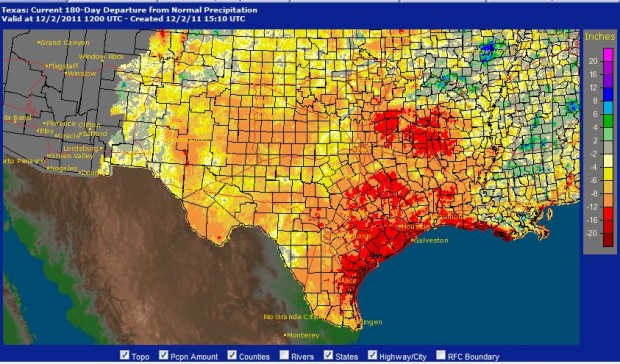Five Ways to Survive the Drought
While rain is making its way across of much of Texas this weekend, it will likely not be enough to bring the state out of its record one-year drought. All of Texas east of Interstate 35, the highway that runs through the middle of the state, needs between eight to twenty more inches of rain to get things back to normal.
“Normal” has become a relative term in the past year. Scientists say the drought is not likely to end until at least next spring, and could continue well into next year or even beyond.
The Texas Parks and Wildlife Department has put together a new “Drought Survival Kit” to help everyday Texans weather the lack of rain. It has some helpful ideas for things you can do that can make life in the drought a little easier:
- Let Your Yard Go Native. Many Texas lawns use thirsty, non-native grasses like St. Augustine. With little rain and water restrictions, these lawns do not do well. The department recommends letting your current lawn die (fall is an ideal time) and planting a “wildscape” of drought-friendly native plants, flowers, trees and grasses instead. “They’re colorful, require little water or care, and attract birds, butterflies and other native wildlife,” the department says. What if your Home Owner Association cites you for not keeping your lawn green? The department says that HOAs “are not allowed to enforce any green-lawn ordinances that contradict local water authority watering restrictions.”
- Save Your Trees. This was a must-do back in August and September, but even with cooler temperatures and some rainfall it’s important to care for your trees. How can you tell if they need water? A simple test using a screwdriver. Try to push a long one into the ground near the trunk of your tree. If it goes in easily, the soil is moist and doesn’t need watering. If you can’t get the screwdriver into the ground, your tree needs water. The Texas Forest Service has put together a helpful video on how to water your trees.
- Firescape Your Home. If you’re in an area that is susceptible to wildfires, it’s a good idea to “firescape” around the perimeter of your home. That means planting ” low-growing, low flammability species that are well within the reach of your water hose,” according to Parks and Wildlife, and keeping this perimeter well-watered. The department also advises thinning out trees and brush in this space, and taking out “ladder fuels” — plants like vines and shrubs that could “carry fire from the ground up into the trees or roof of a house.” There are also tips like removing dead vegetation, woods and clearing up leaves and replacing “dense, flammable vegetation with more fire-resistant plants.”
- Water Efficiently. Much of the state is under water restrictions and some towns are even in danger of running out of water, so using water wisely is a must at this point in the drought. The Texas Water Development Board recommends never watering on windy days, using sprinklers and hoses that spray towards the ground instead of up in the air first, and to do “thorough but infrequent watering.” They say that an inch of water per week during the summer “will keep most Texas grasses healthy.” How do you know when you’ve watered an inch? The board says you can simply “place straight-edged cans at different distances away from the sprinkler and time how long it takes to fill an average of 1 inch of water in each can.” They also say that covering pools and spas “can save the equivalent of your pool volume each year.”
- Harvest the Rain, Mow With a Light Touch. Rainwater collection systems (usually barrels) allow you to harvest the rain from your entire roof and use it to water plants and yards. Some cities like Austin and Plano have rebates for these rain barrel systems. The Water Development Board also suggests more efficiently mowing during hot weather by keeping your grass high. “Taller grass holds moisture better,” the say, and “leave lawn clippings on the lawn instead of bagging.” They also recommend using a good amount of mulch around shrubs and trees. The board says “it will retain moisture, reduce run-off, moderate soil temperatures, and help with weed control.”
This map from the National Weather service shows current rainfall deficits across Texas:


